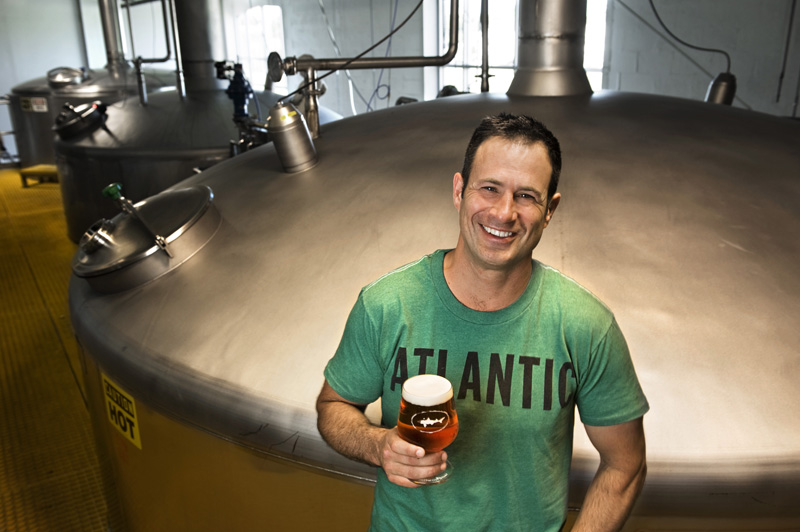Sam Calagione stood in the cab of the old pickup truck and started to put in place the sign for his new brewpub in Rehoboth Beach, Del. His wife, Mariah, had a disposable camera ready to capture the magic moment. First, though, Sam had to remove the sign of the last business at the same spot, a failed restaurant.
Mariah snapped a photo as her husband removed that sign … only to find another aged sign from another business that had also failed. He asked Mariah not to photograph that one.
It was an auspicious beginning this time 20 years ago for Dogfish Head Brewings & Eats, named after a peninsula in Maine where Sam spent boyhood summers. (Mariah grew up near the brewpub’s location, which was only four blocks from the ocean.)
Dogfish Head’s size was all the more auspicious—or audacious, depending on one’s view. It was the nation’s smallest brewery, with Sam brewing 10 gallons at a time thrice daily, five days a week, in a system rigged from three kegs and heated by propane burners. Not the most durable setup for Delaware’s first brewpub, especially in an era when brewpubs, breweries that serve their beers on-site, were generally just starting to take off.
What truly made Dogfish Head a gamble in the spring of 1995, though, was what Sam, a former part-time model turned writer turned homebrewer turned brewer, had in mind for beers. The operation’s first commercial offering was a straight-ahead pale ale using only barley, hops, water and yeast—a simple recipe in the mold of centuries of European-honed brewing.
Then, during that first year, Dogfish Head pivoted to much less traditional beers. Its Chicory Stout, which debuted in 1995 as a winter seasonal, came complete with Saint John’s Wort, a plant that can be used to battle depression; organic Mexican coffee; roasted chicory, another plant, its ground version a potential stand-in for coffee; and licorice root. This was not a simple recipe and it was not in the mold of centuries of European-honed brewing.
For better or worse, the most influential brewer of extreme beer was on its way.
What was extreme beer? Much like the shorthand for obscenity, brewers and consumers alike knew it only when they saw and, more importantly, tasted it. Extreme beer was invariably more complicated than its libationary brethren, with extra and often unusual ingredients beyond yeast, barley, hops and water; it also tended to be higher in alcohol and much busier taste-wise; extreme beer’s packaging even looked busier than other beers.
Dogfish Head was not the first to brew it. That distinction likely belonged to the Boston Beer Co., which launched a line of the strong German lager style known as bock in the late 1980s and then its Utopia series, a regular release of small-batch rarities. Jim Koch, Boston Beer’s principal founder, even had the temerity to suggest then that some Utopia bottles might benefit from aging like wine. Talk about extreme.
As Koch put it years later, when extreme beer, the term itself and the concept, came more into vogue, “The world doesn’t need one more pale ale or more good porter or Hefeweizen. There’s enough of that. Craft brewers have to continue to brew unique, distinctive, even surprising beers.”
While it wasn’t the first, the Calagiones’ creation, which quickly expanded and began distributing outside of Delaware in 1997, became indisputably the most famous producer of these surprising beers. For a time in 2010, Dogfish Head, which is now the nation’s 19th largest brewery by sales volume, had its own Discovery Channel show about—what else?—brewing extreme beer.
Two years before that, Sam starred in a long New Yorker piece on extreme beer in that tony publication’s annual food edition, opposite the Brooklyn Brewery’s Garrett Oliver, who, like many then and now, were skeptical of the whole premise—“unbalanced and shrieking,” for instance, was how Oliver described Dogfish Head’s 120 Minute IPA to writer Burkhard Bilger.
Sam’s summation of the whole brouhaha? “We are trying to explore the outer edges of what beer can be.” That exploration began 20 years ago, and continues.
Read more Acitelli on History posts.
Tom Acitelli is the author of The Audacity of Hops: The History of America’s Craft Beer Revolution. His new book, American Wine: A Coming-of-Age Story, is available for pre-order. Reach him on Twitter @tomacitelli.


Leave a Reply